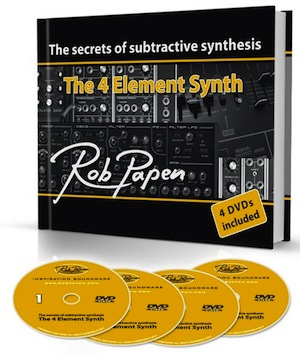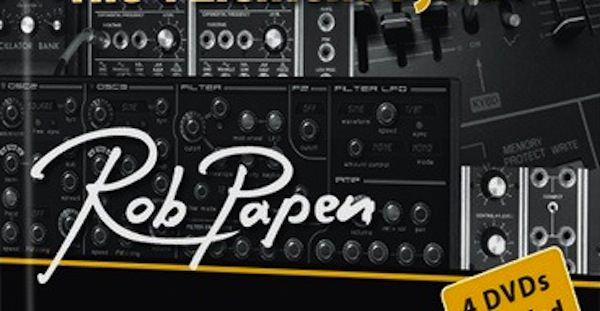Synth developer Rob Papen presents a book and DVD set which aims to provide the definitive guide to subtractive synthesis.
It’s an unavoidable truism that the most talented people don’t always make the best teachers, just as the best athletes don’t always make great coaches and the best musicians don’t always make great producers. Some of the world’s most gifted people find it hard to explain and pass on ideas or techniques which come naturally to them.
 Rob Papen is now best known as a synth developer, but his roots in sound design – and, indeed, as a musician – show that his talents are more diverse than that. In fact, he’s also been running synthesis tutorials in his native Netherlands for over a decade. In The Secrets of Subtractive Synthesis, a set of four DVDs and an accompanying 200-page book, Papen reproduces the training principles employed in his synthesis masterclasses. Any fears that Papen’s skills might not translate to teaching the art of synthesis and sound design are quickly dispelled as you work through the ten hours of video content. The lessons are incisive and well presented, with well-chosen camera angles on hardware synths and overlaid graphics used effectively to illustrate the techniques on show.
Rob Papen is now best known as a synth developer, but his roots in sound design – and, indeed, as a musician – show that his talents are more diverse than that. In fact, he’s also been running synthesis tutorials in his native Netherlands for over a decade. In The Secrets of Subtractive Synthesis, a set of four DVDs and an accompanying 200-page book, Papen reproduces the training principles employed in his synthesis masterclasses. Any fears that Papen’s skills might not translate to teaching the art of synthesis and sound design are quickly dispelled as you work through the ten hours of video content. The lessons are incisive and well presented, with well-chosen camera angles on hardware synths and overlaid graphics used effectively to illustrate the techniques on show.
The Four Elements
The subtitle of the package, The Four Element Synth, hints at Papen’s methodology – both for explaining how subtractive synthesis works and for teaching the art of sound design. The approach breaks subtractive synthesis down into four elements: Element 1 comprises the oscillators, Element 2 is the filter section, Element 3 is the amplifier and Element 4 is ‘modulators’ – which includes just about everything else, from the keyboard itself to envelopes, LFOs and velocity levels.
For complete beginners, the approach is logical, clear and informative. If you’re a relative newcomer to synthesis, or just want to brush up on the fundamentals of sound design, Papen’s approach is a useful way of understanding the building blocks of subtractive synth architecture. The video demonstrations helpfully employ a broad selection of synths including a Minimoog, a Roland Jupiter-8 and Papen’s own Predator plugin in order to explain how each of the principles can be applied to any subtractive synth.
Oddly, the focus on subtractive synthesis only lasts around ten minutes into the first DVD. During the introduction to oscillators, Papen is interrupted by a video of Camel Audio’s Cameleon 5000, narrated by an uncredited female voice rather than by Papen himself. Referring to an additive synth at this early stage is an attempt to explain harmonics and how they relate to wave shapes, but potentially confusing for beginners. It’s a strange mis-step very early into what’s otherwise a very straightforward series of lessons on oscillators.
The principles Papen demonstrates can be applied to any subtractive synth.
The inherent problem with breaking subtractive synthesis down into Papen’s four elements is that each of them is inextricably linked to the others. Attempting to look at each one in isolation risks reducing the entire synth architecture to a near-meaningless over-simplification. As soon as you start to examine anything other than the very basics, it’s impossible to focus solely on one element. For example, Element 3, the amplifier, is little more than a volume and pan control without also considering the amplitude envelope and the note on/off signal used to control it. Likewise, numerous oscillator and filter functions are inherently linked to the modulators found in Element 4.
This problem becomes glaringly apparent around half way through the first DVD – which, up until this point, has ostensibly been an introduction to Element 1 – when Papen suddenly introduces LFOs and modulation envelopes in order to explain pulse width modulation. As such, there are undoubtedly times when the continual references to the Four Element Synth methodology feel slightly unnecessary, but Papen’s overall approach is generally logical, starting with raw oscillator sounds and explaining how they can be shaped into distinct tones. By the time we reach the third DVD, when more complex modulation concepts are introduced, it’s clear that we’ve built to a thorough framework for understanding how to synthesise a wide range of sounds.
The package
Despite the promotion of the package as a book with four bonus DVDs, the primary focus throughout the course is most certainly on the discs and the video content. Papen makes occasional references to the book in the videos, but they’re mainly used to reinforce lessons which have already been covered on the DVDs. In isolation, without the practical examples on the DVDs (and the benefit of hearing the sounds), the book would be much less useful. The printed lessons cover roughly the same content as the videos, but they’re not intended to link together directly throughout the lessons, which is probably preferable to watching a section of video then being sent off to read a chapter of the book before returning. As such, the best approach is to watch the DVDs first, then keep the book on hand as a reference when you’re actually creating sounds.
Watching the DVDs straight through and reading the book as an introduction is a full weekend’s work at the very least, but to get the most out of the package – watching each chapter, digesting the information, cross-referencing with your own synths, trying out some of the tips and techniques you’ve just learnt, then going back over some of the earlier chapters to remind yourself of the interactions between the various elements – you’ll be looking at more like 30 or 40 hours of study.
The best approach is to watch the DVDs first, then keep the book on hand as a reference.
Even for slightly more proficient synth heads, there’s a lot of useful information on offer here. Chances are if you’re relatively experienced with either hardware or software synths you’ll be able to rush through much of the first DVD, but the latter chapters on topics such as oscillator sync and start phase do begin to introduce some slightly more advanced concepts. Unfortunately, the name of the package is perhaps a little misleading; there aren’t many ‘secrets’ on offer in the book, and more advanced synth users may find much of the content too basic.
Conclusion
At £59.95, The Secrets of Subtractive Synthesis isn’t cheap, but the amount of work which goes into producing a comprehensive video training course and printed reference is significant and justifies the RRP. The lessons will introduce you to 99% of the features you might encounter on any given subtractive synth and provide the framework for understanding model-specific options. The lessons emphasise the importance of planning ahead when designing sounds, thinking carefully about the tone you hope to achieve and making informed, logical decisions about the best way to go about creating it using the standard subtractive building blocks.
Papen’s heavily accented English can be a little tricky to understand at times, but he’s otherwise an excellent teacher, albeit prone to the occasional Confucius-style aphorism. “Life is like modulation,” apparently. “You need to address your destination with the right amount.” Right…
The approach of The Secrets of Subtractive Synthesis may not be for everyone – it can be very dry in places and the idea of committing so much time to the course might be anathema to anyone more accustomed to today’s culture of bite-sized YouTube tutorials – but if you have the dedication to follow it through, there’s no doubt that this is one of the most complete guides to the fundamentals of subtractive synthesis that you’re likely to find.

07.41 PM
Aah a review of the book! Was waiting for somebody to do it 😀 Thanks!
12.23 PM
i just finished watching all of it and reading the book along.
amazing tutorial! the best ive seen and ive seen a couple, as sound design was always an important thing for me to understand!
go buy it! it’s really the best thing you can get if you interested learning how to design sounds by yourself without going thru presets.